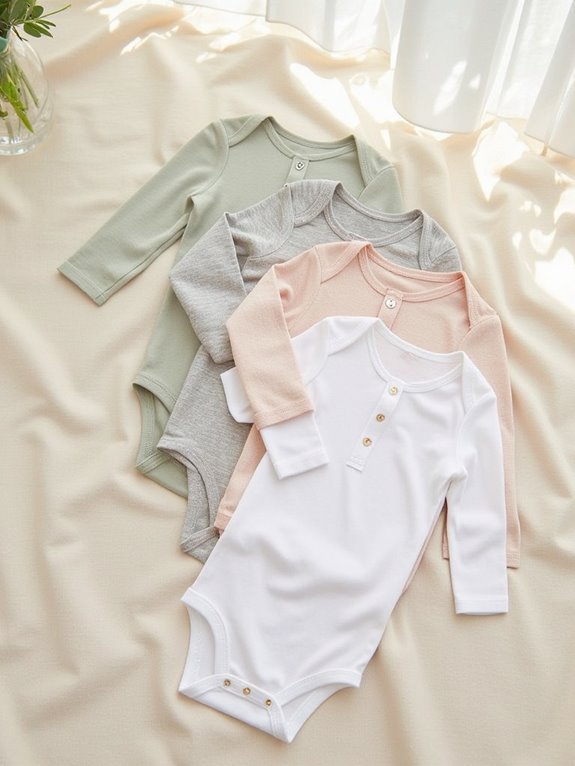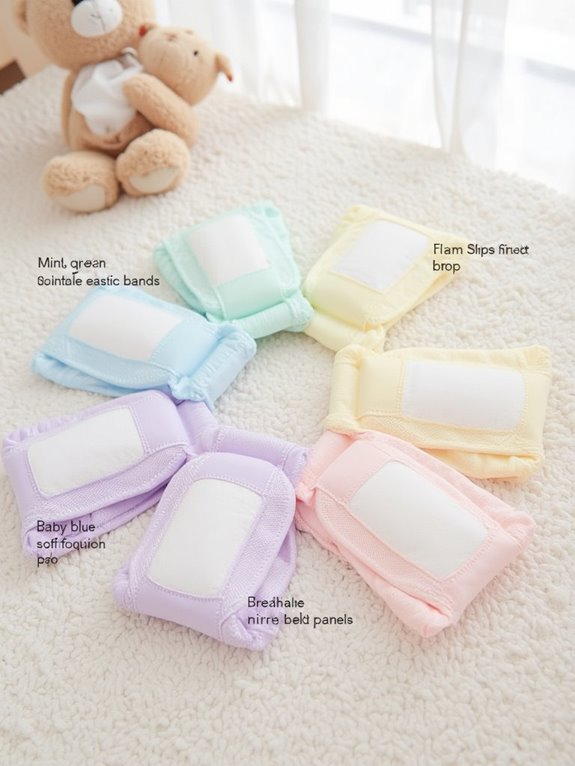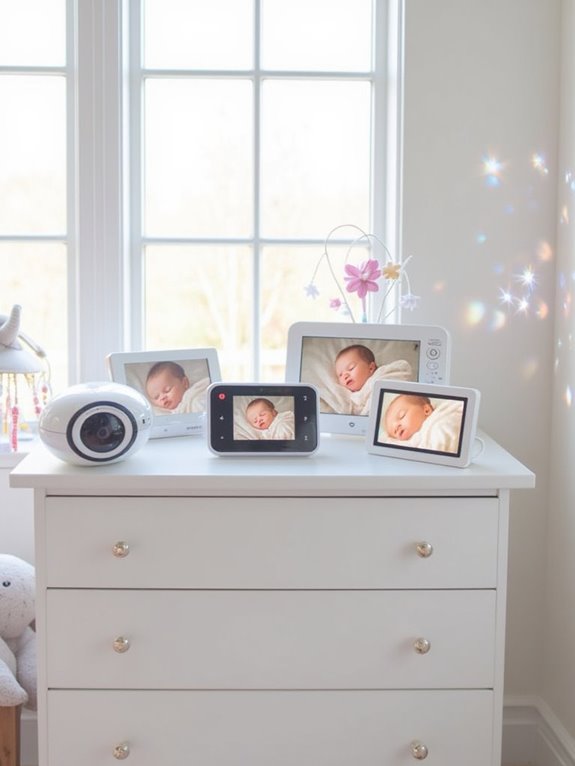Links below are affiliate links. We earn a commission on purchases at no extra cost to you. Although our opinions are based on curated research, we haven't used these products. Articles generated with AI.
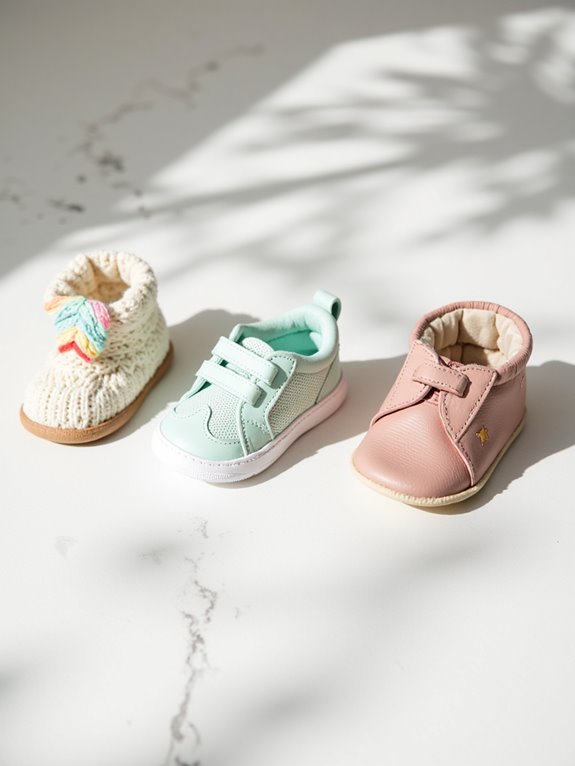
The 3 Best Baby Shoes of 2025 – Comfort Meets Cuteness
For your baby’s first steps in 2025, three standout shoes lead the pack: FEETCITY Baby Walking Shoes offer lightweight flexibility with protective toe coverage and non-slip grips, ideal for 10-16 month infants. LAFEGEN Baby Girls Mary Jane Flats feature scalloped designs with bowknots, combining style with foot development support. Baby Sock Shoes provide breathable mesh with rubber soles for barefoot-like movement. Each option prioritizes proper sizing, grip safety, and natural foot growth. Explore these choices to discover which features best match your little one’s needs.
Key Takeaways
- Focus on flexible soles with non-slip grip patterns, ensuring safety while supporting natural foot movement during early walking stages.
- Choose breathable materials like mesh or soft leather to prevent moisture buildup and promote healthy foot development.
- Look for easy-on designs with stretchable openings and wide entry points to simplify dressing active babies.
- Select shoes with proper sizing, allowing half-inch toe space and regular measurement checks during rapid growth phases.
- Prioritize lightweight construction with protective toe coverage and durable stitching to balance comfort with longevity.
FEETCITY Baby Walking Shoes for Toddlers and Infants
Sale
FEETCITY Wide Baby Sneakers Infant Walking Shoes Boys Girls Baby Sneakers Breathable Non-Slip Infant...
- Wide Toe Box:Unique wide toe wrap design,allows baby to move freely while maintaining body balance and protecting the baby's feet from harm
- Special Design:Adhesive buckle design,well fixed tongue and upper position,will not move in the process of children walking.Adjustable elasticity,suitable for both fat...
- Soft & Breathable:The baby sneakers has a soft padded inner ankle section that helps avoid rubbing and blisters. As a first walking shoes, it's light and flexible and...
FEETCITY Baby Walking Shoes stand out as the ideal choice for parents with infants between 10-16 months who are learning to walk. You’ll find these lightweight, flexible shoes provide essential support while allowing natural foot movement for developing walkers.
Key Features:
- Wide design accommodates chunky feet
- Easy slip-on style with good stretchability
- Protective toe coverage
- Non-slip grip bottom for safety
- Quick-clean, water-resistant material
The shoes’ durability typically spans several weeks of active use, making them a practical choice for early walking stages. While they’re aesthetically pleasing with bear face designs and vibrant colors, their primary strength lies in supporting proper foot development and building walking confidence.
Best For: Parents seeking comfortable, supportive first walking shoes for infants 10-16 months old with wide or chunky feet.
Pros:
- Lightweight and flexible design promotes natural foot movement and walking development
- Easy slip-on style with stretchy material accommodates various foot shapes
- Non-slip bottom and toe protection provide safety features for new walkers
Cons:
- Limited durability with some pairs lasting only a few weeks
- May be outgrown quickly during rapid growth periods
- Higher price point considering the short usage period
LAFEGEN Baby Girls Mary Jane Flats with Bowknot
Sale
LAFEGEN Baby Girls Mary Jane Flats with Bownot Non Slip Soft Sole PU Leather Newborn Infant Toddler...
- SAFE MATERIAL - Our baby girl shoes are super soft & light weight, and Non-Slip bottoms allow your baby to maneuver safely.
- EASY WEAR & STAY ON - Hook and loop closure for easy on and off. Best of all they don't slip off her feet but It is very comfortable for the baby 1st step.
- EXCELLENT GIFT FOE BABY - Suit for any occasion. Flower Girl Shoes/ Birthday Party/ Baby Shower Gift/ Christmas/ Photography/ Dress Up etc.
The LAFEGEN Baby Girls Mary Jane Flats with Bowknot stand out as an ideal choice for parents seeking a versatile first shoe that’ll grow with their infant from crawling to early walking stages. The scalloped design and bowknot detailing provide classic style in tan or bright white options.
These leather flats feature key safety elements:
- Flexible, pliable soles with grip technology for balance
- Lightweight construction for developing feet
- Easy on/off design for quick changes
While sizing runs large (consider ordering down), the shoes’ durability and comfort make them practical for daily wear. The breathable materials and secure fit support natural foot development during crawling and first steps.
Best For: Parents seeking stylish, durable first shoes for infants and early walkers aged 0-18 months who want a versatile option that supports natural foot development.
Pros:
- High-quality leather construction with flexible soles and grip technology for safety during crawling and first steps
- Classic, versatile design with scalloped details and bowknot that pairs well with both casual and dressy outfits
- Easy to put on and remove, with lightweight construction that’s comfortable for developing feet
Cons:
- Sizing runs larger than advertised, requiring most parents to order down a size
- Limited color options, available only in tan and bright white
- May be too loose for very young infants or those with narrow feet
Baby Sock Shoes with Non-Slip Rubber Sole for Infants
Sale
Bearbay Baby Sneakers Girls Boys Lightweight Breathable Mesh Infant Non-Slip First Walkers Shoes
- Indoor/outdoor shoes&walking shoes : These unisex baby slipper shoes are made from soft breathable cotton and non slip rubber Soft Sole. Super Soft and Comfortable fit...
- Comfortable & breathable: These soft slippers are breathable, lightweight, soft and flexible. Let her run around and play wearing these soft slippers that are so cute and...
- Rubber anti collison shoe head: Rubber Anti collision Shoe head, protect your toes, buffer impact, protect your toes from injury. The socks mouth adopts high elastic...
Parents seeking reliable first shoes for beginning walkers will find sock-style footwear with non-slip rubber soles to be an ideal choice. These lightweight shoes feature a stretchy, sock-like upper that allows natural foot movement while providing essential grip on slippery surfaces.
Key benefits include:
- Machine-washable, breathable mesh material
- Flexible design that mimics barefoot walking
- Secure fit that won’t impede toe development
- Non-slip rubber soles for hardwood and tile
While durable overall, some models may show wear near the pinky toes after extended use. For peak performance, ensure proper sizing – these shoes should fit snugly without restricting movement. The sock-shoe design offers an effective balance of protection and mobility for new walkers.
Best For: Parents seeking comfortable, lightweight first walking shoes for infants and toddlers who need grip on slippery surfaces while maintaining natural foot movement.
Pros:
- Easy to put on and take off with stretchy sock-like design that stays secure during wear
- Machine washable and quick-drying with breathable mesh material for comfort
- Non-slip rubber soles provide excellent grip on hardwood and tile floors while allowing natural movement
Cons:
- May show wear near pinky toes after extended use
- Can trap heat causing feet to become sweaty in warm conditions
- Some models may slip off during active movement or when walking on uneven surfaces
Factors to Consider When Choosing Baby Shoes
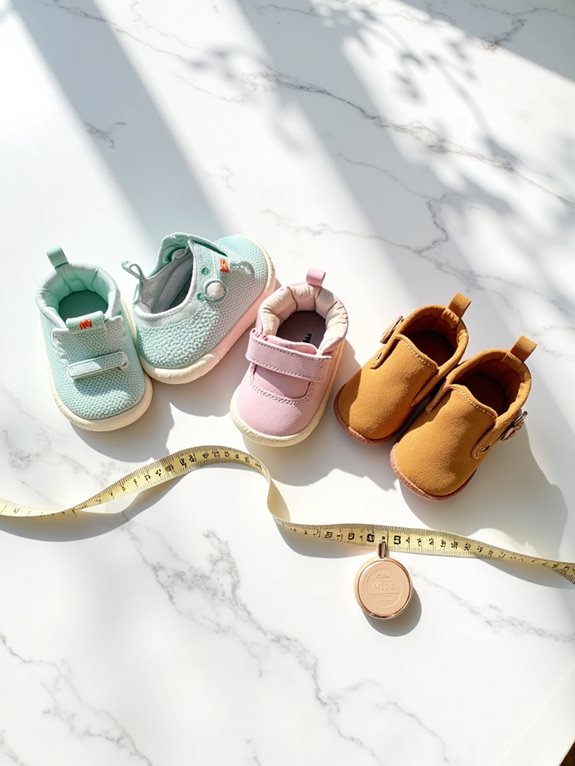
When choosing baby shoes, you’ll need to carefully evaluate several key factors that directly impact your infant’s foot development and safety. You should examine the shoe’s comfort level and proper sizing, breathable materials, adequate support features, flexibility for natural movement, and how easily you can put the shoes on and take them off. These essential considerations will help make certain your baby’s feet develop properly while staying protected during those early walking stages.
Comfort and Proper Fit
Finding properly fitting baby shoes stands as one of the most essential factors in supporting healthy foot development. You’ll want to guarantee there’s approximately a half-inch of space at the front, allowing your baby’s toes to move freely and naturally.
Key fitting guidelines:
- Check that shoes aren’t too tight or loose – proper fit prevents development issues
- Look for soft, flexible materials that mold to your baby’s foot shape
- Ensure adequate arch and heel support without excessive stiffness
- Measure your baby’s feet regularly, as they grow quickly
When evaluating fit, your baby’s shoes should:
- Allow natural toe movement
- Provide stability without restriction
- Stay securely on the foot while walking
- Have enough room for growth without being oversized
Remember to re-check shoe size every few months during your baby’s rapid growth periods.
Material and Breathability
Beyond proper fit, the materials used in baby shoes directly impact foot health and comfort. You’ll want to prioritize shoes made with breathable fabrics that allow proper air circulation and prevent moisture buildup.
Key breathability features to look for:
- Mesh panels or perforated designs that promote ventilation
- Natural cotton or soft leather materials that wick away sweat
- Lightweight, flexible construction that enables air flow
- Easy-to-clean surfaces that maintain foot hygiene
These breathable materials are especially essential during:
- Active playtime
- Warm weather conditions
- Extended wear periods
Support for Growing Feet
As your baby’s feet rapidly develop during their first years, proper support from their shoes becomes essential for healthy growth and development. You’ll want to look for key support features that protect their developing foot structure.
Key Support Elements:
- Flexible soles that allow natural movement while walking
- Wide toe boxes that give toes room to spread and grip
- Built-in arch support to promote proper foot alignment
- Secure fit that’s neither restrictive nor loose
- Stabilizing heel cups for better balance
When evaluating baby shoes, check that they flex easily at the ball of the foot while providing enough structure to prevent wobbling. The shoe should grip your baby’s heel firmly but leave adequate space (about thumb-width) in the toe area for growth. This combination of flexibility and stability helps prevent foot problems while supporting proper walking development.
Flexibility and Natural Movement
While proper support is essential, the flexibility of your baby’s first shoes plays an equally important role in their walking development. You’ll want to look for shoes that easily bend at both the toe and arch areas, mimicking your child’s natural barefoot movement.
Key flexibility features to check:
- Soft, stretchable materials like leather or breathable mesh
- Soles that can be gently twisted and folded
- No rigid support structures that restrict foot muscles
When you’re testing shoes, bend them gently to ensure they flex naturally. Stiff shoes can interfere with your baby’s gait development and make it harder for them to learn proper walking mechanics. The right flexible shoe will also provide better traction, helping prevent slips as your little one explores their environment.
Easy On-Off Design
When selecting baby shoes, convenient on-off design features can make a significant difference in your daily routine. You’ll want to look for shoes that offer:
- Stretchable openings that accommodate various foot shapes
- Elastic bands instead of complicated laces
- Wide entry points for easy access
- Slip-on styles that don’t require fastening
These design elements aren’t just about convenience—they’re essential for quick diaper changes and daily dressing tasks. You’ll find that shoes with flexible openings adapt well to your baby’s growing feet while reducing frustration during busy moments.
As your little one develops, an intuitive design will help them learn to put on and remove their shoes independently. Look for shoes that don’t require multiple steps or complex mechanisms, making the dressing process smoother for both you and your baby.
Grip and Safety Features
Safety-conscious parents must prioritize grip and traction features when selecting baby shoes for their little ones. Your child’s first steps require proper stability across different floor types, from smooth tiles to carpeted surfaces.
Look for these essential safety features:
- Rubber soles with textured patterns
- Non-slip grip zones on high-contact areas
- Traction-enhanced bottom surfaces
These design elements work together to prevent dangerous slips and falls while your baby develops walking skills. The right grip features support natural foot movement and help maintain balance during those critical early mobility stages. When examining potential shoes, test the sole’s grip by running your hand along the bottom – you’ll want to feel a distinct texture that’ll provide reliable traction on both indoor and outdoor surfaces. Proper grip design builds confidence and promotes safer walking development.
Price and Durability Value
Smart parents consider both price and long-term durability when investing in their baby’s first shoes. You’ll want to balance initial costs against how long the shoes will last through your little one’s early walking stages.
When evaluating durability versus price:
- Check stitching quality and sole construction
- Look for reinforced toe areas and heel support
- Examine material thickness and flexibility
- Consider growth rate versus shoe lifespan
While premium shoes often feature higher-quality materials and craftsmanship, you can find budget-friendly options that deliver adequate support. The key is identifying shoes with strong construction basics, regardless of price point. Some less expensive models with quality materials may outlast pricier alternatives. Focus on finding shoes where durability features match your baby’s development stage and activity level, ensuring you get the most value for your investment.
Frequently Asked Questions
How Often Should I Replace My Baby’s Shoes?
You should replace your baby’s shoes every 3-4 months during their first year and every 4-6 months until age 3, as their feet grow rapidly. Check these key indicators for replacement:
- Toes touching the front
- Heel slipping or blisters forming
- Visible wear on soles
- Compressed or misshapen insoles
- Width feels tight
Don’t wait for shoes to be be completely worn out – proper fit is essential for healthy foot development.
Can Babies Wear Hand-Me-Down Shoes From Siblings?
You can use hand-me-down shoes for your baby, but you’ll need to check them carefully first. Inspect the soles for wear patterns, guarantee the support structure isn’t compromised, and verify there’s no interior damage. If the previous child wore them for less than 2-3 months and they show minimal wear, they’re likely safe to use. However, heavily worn shoes should be replaced since proper foot support is essential for development.
Should Babies Wear Shoes While Learning to Walk Indoors?
According to pediatric research, babies who learn to walk barefoot develop 8% better balance and foot strength. When your baby is learning to walk indoors, you shouldn’t put them in shoes. Going barefoot or wearing only non-slip socks allows your child’s feet to grip the floor naturally and develop proper muscle control. You’ll want to save shoes primarily for outdoor protection from rough surfaces and weather. This promotes healthy foot development and walking skills.
At What Age Should Babies Start Wearing Structured Shoes?
You should introduce structured shoes when your baby starts walking outdoors regularly, typically between 12-15 months old. Before this stage, barefoot or soft-soled shoes are best for indoor development. When choosing structured shoes, make certain they:
- Fit properly with room for growth
- Have flexible, non-slip soles
- Provide ankle support without restricting movement
- Are made of breathable materials
Only use structured shoes when necessary for outdoor protection.
What’s the Best Way to Measure a Baby’s Foot Size?
To measure your baby’s foot accurately, follow these key steps:
- Have your baby stand (if able) or sit with feet flat
- Place each foot on a piece of paper
- Mark the heel and longest toe tip with a pen
- Measure the length in inches/centimeters
- Add 1/2 inch (1.27cm) for growth room
You’ll want to measure both feet, as they may differ slightly. For the most precise sizing, measure in the afternoon when feet are naturally more swollen.





